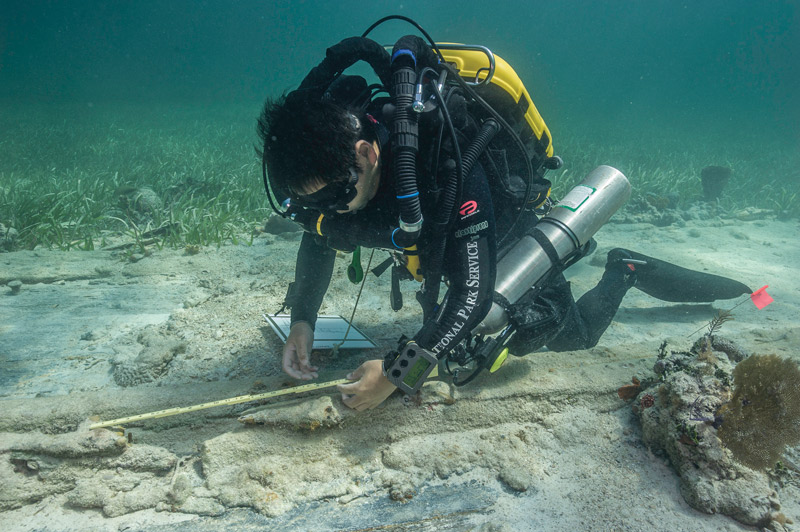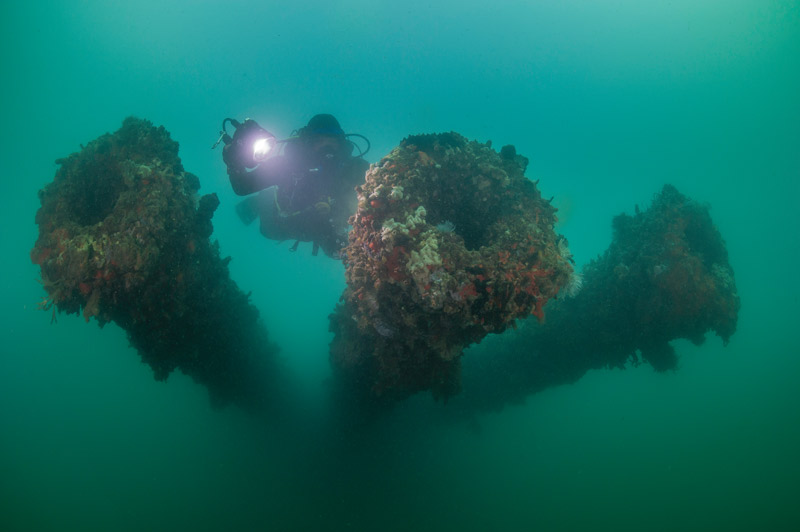Underwater archaeologist Bert Ho (’01) gets up close and personal with shipwrecks as part of his job with the National Park Service’s Submerged Resources Center, which takes him to lakes, rivers, oceans, and beaches in the United States and around the world.
“It’s hard to write or draw a shipwreck underwater when a seal keeps bumping the back of your clipboard with its nose,” says underwater archaeologist Bert Ho (’01).
He would definitely know. Working with the National Park Service’s Submerged Resources Center, Ho has evaluated shipwrecks in parks like Isle Royale, Dry Tortugas, Biscayne, Gulf Islands, Channel Islands, and in nonpark locales like Colombia, South Africa, and Mozambique.
Underwater archaeology doesn’t seem like a career that someone born and raised in Knoxville would gravitate toward, but Ho knew it was exactly what he wanted to do.
“I always swam competitively as a child,” Ho says. “And my older brothers moved to California for careers in the tech industry, exposing me more frequently to the power of the oceans—I wiped out a lot surfing in Santa Cruz.”

Photo by Brett Seymour, Submerged Resources Center, National Park Service
Ho studied anthropology at UT, taking as many classes in the department as possible. Among his favorites were historic archaeology with Charles Faulkner and southeastern archaeology with Gerald Schroedl.
“I would have to say that the archaeology courses were what gave me the best foundation for my career,” Ho says. “Historic archaeology with Professor Faulkner was the first time I heard about shipwrecks being referred to as archaeological sites.”
After completing a graduate program at Florida State University in 2001, Ho became a scientific diver with the Academy of Underwater Sciences and then went on to work with the National Oceanic and Atmospheric Administration as a hydrographer in the Northeast.
In 2010, he began working with the National Park Service, stationed in Denver, Colorado, documenting underwater sites within government-managed areas like parks, marine sanctuaries, and state waters. The agency manages and monitors the sites to protect them for future generations.
“We often get confused with treasure hunters, who are seeking private financial gain by monetizing historic artifacts or precious metals,” Ho explains.
“Underwater archaeologists are scientists who protect and preserve what is underwater for the benefit of all of us, because what is underwater is often reflective of our collective past as a country and the diverse cultures that melded into what is now America.”
On December 7, 2015, Ho was part of a meaningful dive at the USS Arizona to commemorate the events of Pearl Harbor in 1941. He says being a part of the reading of names of the 1,100 sailors and marines on the memorial’s wall was “incredibly humbling.”
“Then when you dive above and around the battleship, knowing that so many young men are entombed in the shipwreck, you cannot help but to think about them, their families, and what a privilege it is to serve them by protecting and managing their ship for years to come,” says Ho. “Being there and seeing the Pearl Harbor survivors, the veterans who still return every year despite being in their nineties, and those that serve currently in our military, was an incredible experience and it really reminds you of who you are serving.
“Those dives truly put the ‘service’ in National Park Service.”

